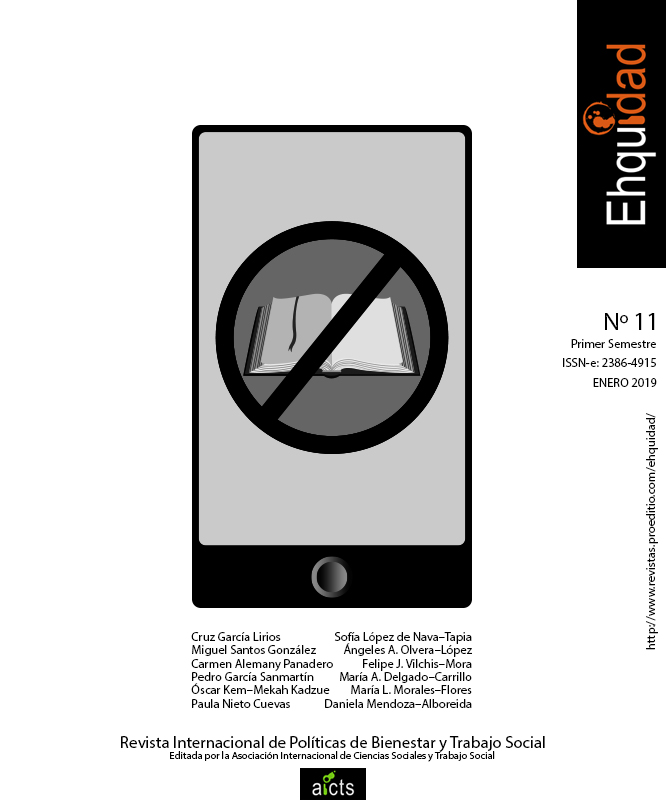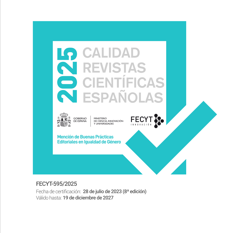Bullying: A door to enter adult antisocial conduct
DOI:
https://doi.org/10.15257/ehquidad.2019.0006Keywords:
Bullying, Social Values, Antisocial Behavior, Adolescents and Education.Abstract
This article is based on a theoretical study about how a deficit of both social values and education in children are the catalysts for bullying behaviour and the gateway to antisocial behaviour in adolescents and adults. It is supported by research and theories regarding the development of children's learning as well as an extensive review of literature, statistical data and expert opinions. This theoretical compendium, plus the current social consequences and statistical data on psychological disorders, is reflecting an increase in two worrying trends. Firstly, the rise in the number of cases of increasingly young children dealing with disorders, such as depression, anxiety, suicides, etc. Secondly, increasing problems in schools such as bullying, dropout, low grades, etc., as well as other antisocial behaviours: early alcohol and drug use, vandalism or theft. This is going to be the main focus of this research, and the conclusions will address the question of the hypothesis: Is there a direct relationship between the lack of social values and prosocial childhood education and the development of antisocial adolescents?
Downloads
References
Ainsworth, M.D. (1979). Infant- Mother attachment. American psycologist, 34(10): 932-937.
AMAFE, Asociación Madrileña Amigos y Familiares de Esquizofrénicos (2014), disponible en: https://www.amafe.org/libro-blanco-de-psiquiatria-del-nino-y-del-adolescente/
Bandura, A., & Rivière, Á. (1982). Teoría del aprendizaje social.
Bandura, A. (1999). Moral disengagement in the perpetration of
inhumanities. Personality and Social Psychology Review, 3 (3), 193-209.
Bandura, A. (2006). Mechanisms of moral disengagement in support of military force. The impact of Sep. 11. Journal of Social and Clinical Psychology, 25 (2), 141-165.
Bowlby, J. (1969). El vínculo afectivo. Buenos Aires: Paidós, 1976.
Eisenberg, N., & Mussen, P. H. (1989). The roots of prosocial behavior in children. Cambridge University Press.
García Gómez, Leonor Alejandra, Mendoza Menéndez, Cinthia Gabriela, Olivares Arizavalo, Kandy, García Pacheco, Marisela, García Montañez, Maritza Verónica, Descripción de funciones neuropsicológicas y de inteligencia en chicos en conflicto con la ley relacionados con bullying Revista Intercontinental de Psicología y Educación [en linea] 2015, 17 (Julio-Diciembre) : [Fecha de consulta: 1 de octubre de 2017] Disponible en:<http://www.redalyc.org/articulo.oa?id=80247939003> ISSN 0187-7690
G. M., Gabriel (1995). Disponible en: http://www.eltiempo.com/archivo/documento/MAM-418135
Gardner, H. (1998). Inteligencias múltiples. Barcelona: Paidós.
Genovés, V. G. (2001). El psicópata: Un camaleón en la sociedad actual. Círculo de Lectores, 90-91.
Gómez del Castillo Segurado, M. T. (2007). Videojuegos y transmisión de valores. Revista Iberoamericana de Educación, 43 (6), 1-10.
Hospital Sant Joan de Déu de Barcelona con la colaboración de Laboratorios Ordesa (2016). Disponible en: http://faros.hsjdbcn.org/es/cuaderno-faro/adolescentes-trastornos-comportamiento-como-podemos-detectarlos-debe-hacer.
INE, Instituto Nacional de Estadística (2018), disponible en: http://www.ine.es/dyngs/INEbase/es/operacion.htm?c=Estadistica_C&cid=1254736176795&menu=ultiDatos&idp=1254735573206
Kohlberg, L. (1974). Desarrollo moral. Enciclopedia internacional de las ciencias sociales, 7, 222-232.
Lykken, D. T. (2000). Las personalidades antisociales. Herder, 47-60
Lochener, Lonce (2014), Fundación UNAM. Disponible en: http://www.fundacionunam.org.mx/educacion/relacion-educacion-delincuencia/
Navarro-Pérez, J. J., & Pastor-Seller, E. (2017). Factores dinámicos en el comportamiento de delincuentes juveniles con perfil de ajuste social. Un estudio de reincidencia. Psychosocial Intervention, 26(1), 19-27.
Main, M. y Solomon, J. (1986). Discovery of a new, isecure-disorganized/disoriented attachment pattern. En T.B. Brazelton y M. Yogman (Eds.), Affective development in infancy. Norwood, NJ: Ablex.
Manrique, V. E. C., Ellis, A., & Lega, L. I. (2002). Teoría y práctica de la terapia racional emotivo-conductual.
Pérez Arellano, Enrique, Castañeda Ramírez, Irma, El impacto de los estilos parentales en la dinámica de bullying a nivel secundaria Revista Intercontinental de Psicología y Educación [en linea] 2015, 17 (Julio-Diciembre) : [Fecha de consulta: 1 de octubre de 2017],Disponibleen:<http://www.uacm.kirj.redalyc.redalyc.org/articulo.oa?id=80247939005> ISSN 0187-7690
Piaget, Jean, "El criterio moral en el niño", Ed. Fontanella, Segunda Edición, Barcelona, 1974. Traducción de "Le jugement moral chez l'enfant", Alcan, Paris, 1932.
RAE, Real Academia de la Lengua Española, (2017). Disponible en: http://www.rae.es/
Robinson, K., & Aronica, L. (2015). Escuelas creativas: La Revolucin Que Est Transformando La Educacin. Vintage Espanol.
Rodrigo Cacho (2018), Ángeles Carreres (2018). Disponible en: https://elpais.com/economia/2018/04/13/actualidad/1523620708_309114.html
Rosenthal, R., & Jacobson, L. (1968). Efecto Pigmalión en el aula.
Sanmartín, P. G. (2017). Padres sin tiempo para transmitir valores. EHQUIDAD. Revista Internacional de Políticas de Bienestar y Trabajo Social, (8), 119-160.
Sanmartín, P. G. (2018). Una aproximación a la etiología de la desigualdad de género. EHQUIDAD. Revista Internacional de Políticas de Bienestar y Trabajo Social, (9), 145-178.
Freud, S., Strachey, J., & Freud, A. (2002). Más allá del principio del placer. RBA Coleccionables.
Swartz, RJ, Costa, AL, Beyer, BK, Reagan, R., y Kallick, B. (2010). Aprendizaje basado en el pensamiento: promoción del rendimiento estudiantil de calidad en el siglo XXI . Teachers College Press. 1234 Amsterdam Avenue, Nueva York, NY 10027.
UNESCO, (2017), Informe de seguimiento de la educación en el mundo. Rendir cuentas en el ámbito de la educación: Cumplir nuestros compromisos. Disponible en: http://unesdoc.unesco.org/images/0026/002610/261016S.pdf
Voors, W. (2000). Bullying: el acoso escolar. Barcelona: Oniro.
Wertheimer, M., & Wolfson, L. (1991). El pensamiento productivo.
Downloads
Additional Files
- BULLYING: UNA PUERTA DE ENTRADA A LA CONDUCTA ANTISOCIAL ADULTA (Español (España))
- BULLYING: UNA PUERTA DE ENTRADA A LA CONDUCTA ANTISOCIAL ADULTA (Español (España))
- BULLYING: UNA PUERTA DE ENTRADA A LA CONDUCTA ANTISOCIAL ADULTA (Español (España))
- BULLYING: UNA PUERTA DE ENTRADA A LA CONDUCTA ANTISOCIAL ADULTA (Español (España))
- BULLYING: UNA PUERTA DE ENTRADA A LA CONDUCTA ANTISOCIAL ADULTA (Español (España))
- BULLYING: UNA PUERTA DE ENTRADA A LA CONDUCTA ANTISOCIAL ADULTA (Español (España))
- BULLYING: UNA PUERTA DE ENTRADA A LA CONDUCTA ANTISOCIAL ADULTA (Español (España))












